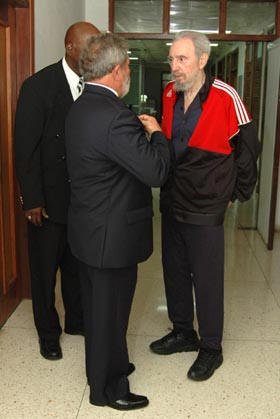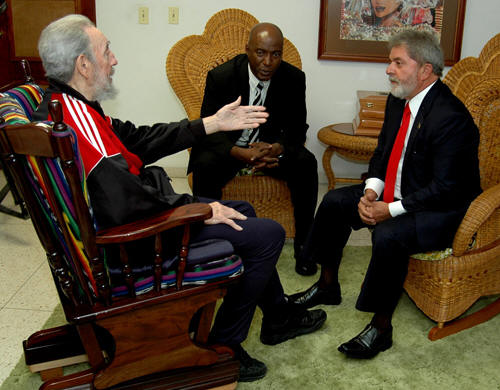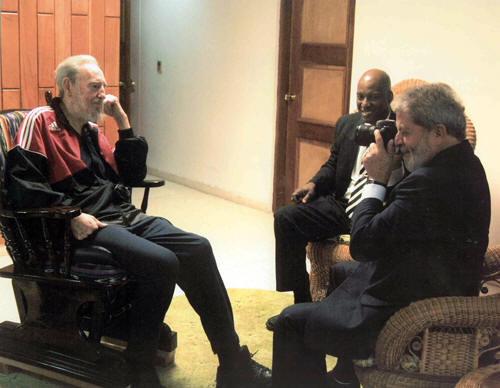
January 14, 2008
A CubaNews translation by Ana Portela.
Edited by Walter Lippmann. Original:
http://www.granma.cubaweb.cu/2008/01/14/nacional/artic03.html
Biography of the
President of the
Federal Republic of Brazil, L uiz
Inácio Lula da Silva
uiz
Inácio Lula da Silva
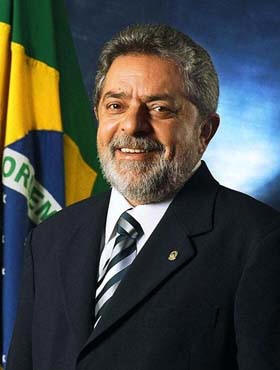 Luiz
Inácio Lula da Silva was born on October 27, 1945, in the city of Garanhuns, Pernambuco. He
has been married to Marisa Leticia since 1974 with whom he has five
children. He is the seventh son of the eight his parents, Arístides
Inácio da Silva y Eurídice Ferreira de Mello, had. In December of 1952
Lula and his family moved to the coastal region of Sao Paulo.
Luiz
Inácio Lula da Silva was born on October 27, 1945, in the city of Garanhuns, Pernambuco. He
has been married to Marisa Leticia since 1974 with whom he has five
children. He is the seventh son of the eight his parents, Arístides
Inácio da Silva y Eurídice Ferreira de Mello, had. In December of 1952
Lula and his family moved to the coastal region of Sao Paulo.
In 1969 the Metallurgy Union of Sao Bernardo do Campo and Tiara elected a new direction and Lula was elected as substitute. In 1975 he was elected union president with 92% of the votes and became representative of 100 000 workers.
In March of 1979, 170 000 metallurgy workers paralyzed the Sao Paulo ABC. Police repression of the strike and almost total absence of politicians to represent the interests of the workers, the National Congress urged Lula to consider creating the Workers Party.
On February 10,1980 Lula founded the Workers Party (WP) together with other union members, intellectuals, politicians and representatives of social movements with rural and religious leaderships. In 1980 a new strike by metallurgy workers resulted in the intervention of the Federal Government of the union and imprisonment of Lula and other union leaders under the pretext of the Law of National Security. Lula spent 31 days in prison.
By 1982 the WP had spread throughout the national territory with Lula as leader of the Party and later challenged the Government of Sao Paulo. In August of 1983 he took part in the foundation of the Unity Workers Central. In 1984 he participated as one of the main leaders in the campaign “direct-now” for the presidency of the Republic. In 1986 he was the most voted federal deputy in the country for the Constituent Assembly.
The WP launched Lula as candidate for the Presidency of the Republic in 1989. He lost the election in the second round by a small difference. Two years later he led a national mobilization against corruption. Two times more, in 1994 and 1998, Lula ran for president but was defeated.
Since 1992 Lula also acted as advisor of the Citizenship Institute.
In June of 2002 the National Convention of the WP approved a broad alliance with other parties with a government program to rescue the main social debt the party had with the great majority of the Brazilian people. On October 27, 2002 and with almost 53 million votes Luis Inacio Lula da Silva was elected President of the Federative Republic of Brazil.
On October 29, 2006 Luiz Inácio Lula da Silva of the WP was reelected President of the Republic with more than 58 million votes (60,83% of valid votes).
President Luiz Inácio Lula da Silva arrives in Cuba today
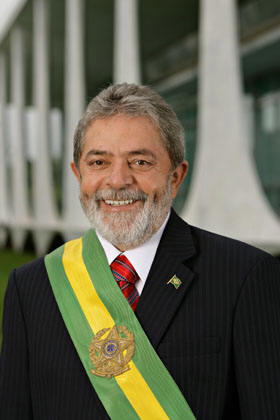 His
Excellency Mister Luiz Inácio Lula da Silva,
President of the Federal Republic of Brazil, arrives fulfilling an
official visit to our country.
His
Excellency Mister Luiz Inácio Lula da Silva,
President of the Federal Republic of Brazil, arrives fulfilling an
official visit to our country.
The Brazilian president is accompanied by a large delegation of several ministers and high officials that include the Foreign Affairs Minister, Celso Amorim; the Minister of Development, Trade and Industries, Miguel Jorge; the Minister of Education, Fernando Haddad; the Minister of Health, José Gomes Temporão and President of Petrobras, José Sérgio Gabrielli de Azevedo.
The visit of the South American head of state contributes to deepen relations of friendship and cooperation that exist between the two countries. During this visit several agreements will be signed in areas of mutual interest.
During his visit to our country, President Lula de Silva will hold official talks with the First Vice President of the Council of State and Ministers, General Raul Castro and will visit areas of historical, scientific and educational interest.
 5
questions on Brazil
5
questions on Brazil
DEISY FRANCIS MEXIDOR
Francis_mexidor@granma.cip.cu
1.— Where is Brazil?
The Federative Republic of Brazil is the largest in South America and
fifth largest in the world. It borders with all the South American
nations with the exception of Chile and Ecuador. To the north it shares
borders with Colombia, Venezuela, Guyana, Surinam and French Guyana; to
the south borders Argentina, Uruguay and Paraguay; to the east it is
bathed by the Atlantic Ocean and to the west it has common borders with
Bolivia and Peru. Its capital is Brasilia founded in 1960 instead of Rio
de Janeiro. The political-administrative division of the country is made
up by 26 states, the Federal District and about 5500 municipalities. It
has a total surface of 8,514,877 square kilometers and a population that
surpasses 183 million inhabitants, according to statistics of April
2007. The majority of the Brazilians are concentrated around the
Atlantic Ocean, specially the great cities of Sao Paulo and Rio de
Janeiro. The official language is Portuguese and the currency is the
Real. The national holiday is the Grito de Ipiranga on September 7, 1822
as Independence Day.
2.— What is the etiology
of its name?
According to national tradition, the current territory of Brazil was
discovered by the Portuguese navigator, Pedro Alvarez Cabral who reached
the beach of Puerto Seguro, now in the state of Bahía on April 21, 1500.
Colonization began in 1549.
There was a tree in the region, the Caesalpinia echinata which the Portuguese called pau-brasil that seeped a red color when boiled in water and recalled burning carbon. That is the origin of the name terra do pau-brasil. During colonization the Portuguese exported this new dye for clothes and the pau-brasil was almost wiped out. Now there are government programs to protect and recover this tree.
3.— What is its geography
and natural wealth?
The so-called high lands of Brazil or Brazilian plateau and the Amazon
basin – the largest flowing river in the world – are the distinguishing
features of Brazil. The plateau is an eroded altiplano that occupies the
greatest part of the country with a height that varies from 305 to 915
meters. The Pico da Neblina (3014 meters) in the Serra do Imeri
bordering with Venezuela is the highest point. The length of the Amazon
from Iquitos, in Peru to its basin is 3700 kilometers all of allows
coastal navigation.
It has the largest forest wealth in the world, Amazonia that extends across almost five million square kilometers and supplies 20% of the drinking water and 25% of oxygen of the world.
4.— What are some of the
characteristics of its current economic situation?
It is the largest coffee producer in the world and has the greatest
mineral resource which suffered intense exploitation during the 1980s.
It had a rapid industrial growth during the sixties and seventies until,
in the following decade it achieved a diverse modern economy achieving
inclusion among the ten first powers in the world economy.
The Brazilian Growth Domestic Product of Brazil grew 5,3% in 2007. Also, between January and November of last year 1,93 million jobs were created causing a strong credit expansion increasing the population’s purchasing power. The government supplies “family-bonds” to 11 million poor homes to satisfy the basic needs. During his first administration, Lula reduced poverty by seven million persons, infant malnutrition fell from 18 to 6,6% and 37 children receive a free snack for the first time in the nation. The minimum salary also tripled, increasing purchasing power.
Investment plans for 2008 are aimed at the Plan of Rapid Growth with investments in the following sectors: transportation, energy, housing health conditions; in addition to a strict plan of budget austerity and goals of lowering inflation under the responsibility of the Banco Central. Brazilian exports represent about 118 billion dollars and is among the twenty largest in the world.
5.— Historically what
have been the relations between Brazil and Cuba?
Relations between Brazil and Cuba go back to November 9, 1871 when the
South American nation recognized the legitimacy of the Cuban Republic in
Arms. Both nations established consular relations in 1906 and embassy
level in 1943.
After the triumph of the Cuban Revolution, Brazil abstained in the OAS meeting in 1962 in Punta del Este that condemned the new socialist state. When a military coup overthrew Joao Goulart in 1964 the new military government broke relations with the Island.
Since the re-establishment of mutual ties on June 14, 1986 relations between both countries have developed in all issues and future increases of trade and collaboration in many fields are truly promising.
The visit of Luiz Inácio Lula da Silva is inscribed in the framework of these relations.
Upon learning of his re-election our Comandante en Jefe sent the following message on October 30, 2006: Dear Lula: I never doubted that your victory would be the best for Latin America and Brazil. For this reason I congratulate you on your victory.”
Sources consulted
http://www.indexmundi.com/es/
Wikipedia Archivo de Granma Prensa de Brasil
Almanaque Mundial 2005
original:
http://www.granma.cubaweb.cu/2008/01/14/interna/artic02.html
Llegará hoy a Cuba, el Presidente Luiz Inácio Lula da Silva
 El
excelentísimo señor Luiz Inácio Lula da Silva, Presidente de la
República Federativa del Brasil, llegará hoy para cumplimentar una
visita oficial a nuestro país.
El
excelentísimo señor Luiz Inácio Lula da Silva, Presidente de la
República Federativa del Brasil, llegará hoy para cumplimentar una
visita oficial a nuestro país.
El Presidente brasileño viajará acompañado de una amplia delegación integrada por varios ministros y altos funcionarios, entre ellos el Ministro de Relaciones Exteriores, Celso Amorim; el Ministro de Desarrollo, Comercio e Industrias, Miguel Jorge; el Ministro de Educación, Fernando Haddad; el Ministro de Salud, José Gomes Temporão y el Presidente de Petrobras, José Sérgio Gabrielli de Azevedo.
La visita del mandatario suramericano contribuirá a profundizar las relaciones de amistad y cooperación existentes entre los dos países. En el marco de la misma se firmarán varios acuerdos en áreas de interés común.
Durante su estancia en nuestro país, el Presidente Lula da Silva sostendrá conversaciones oficiales con el Primer Vicepresidente de los Consejos de Estado y de Ministros, General de Ejército Raúl Castro Ruz y recorrerá lugares de interés histórico, científico y educacional.
http://www.granma.cubaweb.cu/2008/01/14/cubamundo/artic01.html
Biografía del Presidente de la República
Federativa del Brasil
Luiz Inácio Lula da Silva
 Luiz
Inácio Lula da Silva nació el 27 de octubre de 1945, en la ciudad de
Garanhuns, Pernambuco. Casado con Marisa Leticia desde 1974, tiene cinco
hijos. Lula es el séptimo de los ocho hijos de Arístides Inácio da Silva
y Eurídice Ferreira de Mello. En diciembre de 1952, la familia de Lula
migró para el litoral paulista.
Luiz
Inácio Lula da Silva nació el 27 de octubre de 1945, en la ciudad de
Garanhuns, Pernambuco. Casado con Marisa Leticia desde 1974, tiene cinco
hijos. Lula es el séptimo de los ocho hijos de Arístides Inácio da Silva
y Eurídice Ferreira de Mello. En diciembre de 1952, la familia de Lula
migró para el litoral paulista.
En 1969, el Sindicato de los Metalúrgicos de Sao Bernardo do Campo y Tiara hizo elección para escoger una nueva dirección y Lula fue elegido suplente. En la elección siguiente, en 1972, se hizo primero-secretario. En 1975, fue electo presidente del sindicato con 92% de los votos, pasando a representar a 100 000 trabajadores.
En marzo de 1979, 170 000 metalúrgicos paralizaron el ABC paulista. La represión policial al movimiento huelguista y la casi inexistencia de políticos que representaran los intereses de los trabajadores en el Congreso Nacional contribuyó a que Lula pensara en crear el Partido de los Trabajadores.
El 10 de febrero de 1980, Lula fundó el Partido de los Trabajadores (PT), junto con otros sindicalistas, intelectuales, políticos y representantes de movimientos sociales, con liderazgos rurales y religiosos. En 1980, una nueva huelga de los metalúrgicos provocó la intervención del Gobierno Federal en el sindicato y la prisión de Lula y otros dirigentes sindicales, con base en la Ley de Seguridad Nacional. Lula estuvo 31 días en prisión.
En 1982, el PT ya estaba implantado en casi todo el territorio nacional. Lula lideró la organización del Partido y disputó aquel año el Gobierno de Sao Paulo. En agosto de 1983, participó de la fundación de la Central Única de los Trabajadores. En 1984, participó como uno de los principales líderes de la campaña de las "directas-ya" para la Presidencia de la República. En 1986, fue elegido el diputado federal más votado del país para la Asamblea Constituyente.
El PT lanzó a Lula para disputar la Presidencia de la República en 1989. Perdió la disputa, en el segundo turno, por pequeña diferencia de votos, pero dos años después lideró una movilización nacional contra la corrupción. En 1994 y 1998, Lula volvió a presentarse a las presidenciales, pero fue derrotado.
Desde 1992, Lula también actuaba como consejero del Instituto Ciudadanía.
En junio del 2002, la Convención Nacional del PT aprobó una amplia alianza política con otros partidos, que tuvo por base un programa de Gobierno para rescatar las deudas sociales fundamentales que el país tenía con la gran mayoría del pueblo brasileño. El 27 de octubre del 2002, con casi 53 millones de votos, Luiz Inácio Lula da Silva es electo Presidente de la República Federativa del Brasil.
El 29 de octubre del 2006, Luiz Inácio
Lula da Silva, del PT, es reeligido Presidente de la República con más
de 58 millones de votos (60,83% de los votos válidos).
http://www.granma.cubaweb.cu/2008/01/14/nacional/artic03.html
5 preguntas sobre Brasil
DEISY FRANCIS MEXIDOR
Francis_mexidor@granma.cip.cu
 1.—¿Dónde
se ubica Brasil?
1.—¿Dónde
se ubica Brasil?
La República Federativa del Brasil posee el territorio más extenso de América del Sur y el quinto del mundo. Tiene límites con todos los países sudamericanos, a excepción de Chile y Ecuador. Al norte limita con Colombia, Venezuela, Guyana, Surinam y la Guayana Francesa; al sur con Argentina, Uruguay y Paraguay; al este con el Océano Atlántico; y al oeste con Bolivia y Perú. Su capital es Brasilia, que sustituyó a Río de Janeiro en 1960.
La división político-administrativa del país incluye 26 estados, el Distrito Federal y más de 5 500 municipios. La superficie total es de 8 514 877 kilómetros cuadrados, y su población supera los 183 millones de habitantes, según datos de abril del 2007. La mayoría de los brasileños vive junto al océano Atlántico, especialmente en las grandes ciudades de Sao Paulo y Río de Janeiro. La lengua oficial es el portugués y la moneda, el Real. Se estima la expectativa de vida al nacer en 72,24 años.
El 7 de septiembre de 1822 (Grito de Ipiranga) es fecha nacional. Se celebra el Día de la Independencia.
2.—¿De dónde proviene su nombre?
Según la teoría tradicional el actual territorio de Brasil fue descubierto por el navegante portugués Pedro Alvares Cabral, quien llegó a la playa de Puerto Seguro, en el actual estado de Bahía, el 21 de abril de 1500. En 1549 comenzaría su colonización.
En la región existía un árbol (Caesalpinia echinata), denominado por los portugueses árbol pau-brasil, que desprendía un color rojizo al hervirse en agua y recordaba las brasas del carbón ardiendo. De ahí el nombre a la terra do pau-brasil. Durante la colonización, los portugueses exportaron ese nuevo tinte para teñir sus ropas, y el pau-brasil casi llegó a extinguirse. En la actualidad, existen programas gubernamentales para la recuperación del árbol.
3.—¿Cómo son su geografía y riquezas naturales?
Las llamadas tierras altas brasileñas o meseta brasileña, y la cuenca del río Amazonas —el mayor y más caudaloso del orbe— son los rasgos fisiográficos dominantes de Brasil. La meseta es un altiplano erosionado que ocupa la mayor parte del país, con una altura que varía entre los 305 y los 915 metros. El Pico da Neblina (3 014 metros), situado en la Serra do Imeri, en la frontera con Venezuela, es su punto más elevado. La longitud del Amazonas desde Iquitos, en Perú, hasta su desembocadura es de 3 700 kilómetros, todos navegables por barcos de cabotaje.
Posee la mayor riqueza boscosa del mundo, la Amazonia, que se extiende por casi cinco millones de kilómetros cuadrados y proporciona nada menos que el 20% del agua potable mundial y el 25% del oxígeno que hay en el globo terráqueo.
4.—¿Cuáles son algunas de las características de su actual situación económica?
Es el mayor productor de café en el mundo y posee grandes recursos minerales; la explotación de muchos de ellos se intensificó durante la década de 1980. Experimentó un rápido crecimiento industrial entre los sesenta y setenta, hasta que en la siguiente década logró una economía moderna diversificada, que llevó a ese vasto territorio a incluirse entre las diez primeras potencias de la economía mundial.
El Producto Interno Bruto de Brasil creció 5,3% en el 2007. Además, entre enero y noviembre del pasado año se crearon 1,93 millones de empleos, que provocaron una fuerte expansión del crédito, elevando el poder adquisitivo de la población. La meta es crecimiento con inclusión social. El Gobierno proporciona "becas-familia" a 11 millones de hogares pobres para satisfacer el consumo de bienes básicos. En su primer mandato, Lula, redujo la pobreza en siete millones de personas, la desnutrición infantil bajó de 18 a 6,6% y 37 millones de niños recibieron merienda gratuita por primera vez en la nación, además de haber triplicado el salario mínimo que aumentó su poder de compra.
Las inversiones previstas para el 2008 están destinadas al Plan de Aceleración del Crecimiento, con inversiones en los sectores: transportes, energía, vivienda y saneamiento; paralelamente a un estricto plan de austeridad fiscal y metas de baja inflación a cargo del Banco Central. Las exportaciones brasileñas de unos 118 000 millones de dólares, se encuentran entre las veinte más grandes del mundo.
5.—¿Cómo han sido históricamente las relaciones entre Brasil y Cuba?
Las relaciones entre Brasil y Cuba se remontan al 9 de noviembre de 1871, cuando ese país sudamericano reconoció la legitimidad de la República de Cuba en armas. Ambas naciones establecieron relaciones a nivel consular en 1906 y con rango de embajada en 1943.
Luego del triunfo de la Revolución cubana, Brasil se abstuvo en la reunión de la OEA en 1962, en Punta del Este, donde se condenó al entonces naciente Estado socialista. A raíz del golpe militar que depuso a Joao Goulart, en 1964, el nuevo régimen castrense rompió relaciones con la mayor de las Antillas.
Desde el restablecimiento de los vínculos mutuos, el 14 de junio de 1986, los nexos entre los dos países se han ido desarrollando, en todos los órdenes, y las perspectivas de incremento del comercio y la colaboración en numerosas ramas son realmente promisorias.
La visita de Luiz Inácio Lula da Silva se inscribe en el marco de esas relaciones.
Al conocerse el resultado de su reelección, nuestro Comandante en Jefe le envió el siguiente mensaje el 30 de octubre del 2006: "Estimado Lula: Nunca tuve la menor duda de que una victoria tuya sería lo mejor para América Latina y para Brasil. Por ello me complace felicitarte por tu victoria".
Fuentes consultadas.
http://www.indexmundi.com/es/
Wikipedia
Archivo de Granma
Prensa de Brasil
Almanaque Mundial 2005
http://www.granma.cubaweb.cu/2008/01/14/interna/artic02.html
